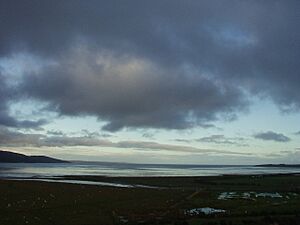River Bladnoch facts for kids
The Bladnoch River is a river in Wigtownshire, located in the area called the Machars of Galloway in southwest Scotland. It's an important waterway in the region. One of the first times this river was written about was in the 1600s by Sir Andrew Agnew and Sir David Dunbar. They described it flowing from the mountains of Penninghame towards the south.
They wrote that the river goes through Loch Maberry, which has a small island with a house on it. Along its way, other smaller streams join it. The most important one is the Tarf Water, which starts in the Muirs of Luce. The Bladnoch then turns east and, after flowing for about 32 kilometers (20 miles) from its start, it empties into Wigtown Bay, near a place called Baldone.
Contents
Journey of the Bladnoch River
The Bladnoch River begins its journey at Loch Maberry, which is in the area of Kirkcowan. From there, it flows south towards Polbae. As it travels south, a stream called Reoch Burn joins it while it passes through Carseriggan Moor.
The river continues past Isle-na-Gower. Here, it forms a border between the tree-covered land at Hopeless Howe and an area called the Ring of Barfad. Soon after, another stream, Black Burn, flows into it. At this point, the river has Barnley Plantation on its east side.
You can cross the river using stepping stones, which are part of a small road connecting Mark of Shennanton with Little Eldrig. A little further on, the river gets wider for a short bit at a place called Broad Wheel.
Bridges and Waterfalls
Continuing south, the river is crossed by Shennanton Bridge, where the main A75 road goes over it. Next, you'll find Linn Wood and a waterfall known as Linn of Barhoise. The river then flows past Barhoise Farm to Barhoise Mill.
Back in 1684, people used to fish for salmon here with nets on both the Bladnoch and the Tarf Water. The owner of Craichlaw had special fishing rights at Barhoise Mill. Barhoise Mill itself is an old building made of granite and slate. It's quite old, with a date stone saying 1827, but it's likely a rebuild of an even older mill. This mill was powered by a large water wheel, but only its wooden axle remains today.
Where Rivers Meet
Just east of Kirkcowan, the Bladnoch River meets the Tarf Water. A couple of miles downstream from this meeting point, other landowners also had rights to catch salmon using nets. They sometimes even fished together and shared their catch equally.
Knights Templar and Old Crossings
During the time of King David I (who ruled from 1124 to 1153), a group called the Knights Templar came to Galloway. These knights wore white clothes with a red cross. They ran places called "Inns of Hospitality" to help travelers. One of these inns was right next to the Spittal of Bladnoch. This was an important crossing point on the main road that went from Wigtown to Portpatrick and on to Ireland.
Mills and Industry
About 1.6 kilometers (1 mile) south of Dalreagle, in the area of Kirkinner, the Water of Malzie flows into the Bladnoch. Soon after, the river reaches Torhouse Mill. This was one of the early mills that also had a farm, and it was used to grind corn. You can still see parts of the wheelpit and the channel that brought water to the mill, which was built in the 1800s.
Very close by, there are also the ruins of a "waulkmill," which was a factory that made wool. By 1792, this factory employed 40 workers who made "plaiding and flannel" to sell to England. Further downstream, there was once a mill that made "farina," a type of food.
Newmilns is another old mill site, about 3 kilometers (2 miles) west of Wigtown. It was a small, three-story mill built into the river bank. Today, the building is empty and used for storage. You can still see the remains of its large water wheel, which was about 5 meters (16 feet) across and 1.5 meters (5 feet) wide. The only modern business on this part of the river is a trout farm, which opened in the 1970s on the site of the old Torhouse grain mill.
Scenic Views and Salmon Pools
After passing these old mills, the river flows through Cotland and Kirwaugh Plantations. People say the scenery here is the most beautiful along the river's entire 24-kilometer (15-mile) length. After all these trees, the river flows into a large pool called Linghoor. Since the 1700s, this pool has been famous as one of Scotland's best places for salmon fishing.
The buildings that used to be part of the Bladnoch Creamery are on the south side of the river, near an old crossing point. From here, the river makes several wide turns until it passes Wigtown harbor. Finally, it flows out into Wigtown Bay, joining the sea.


